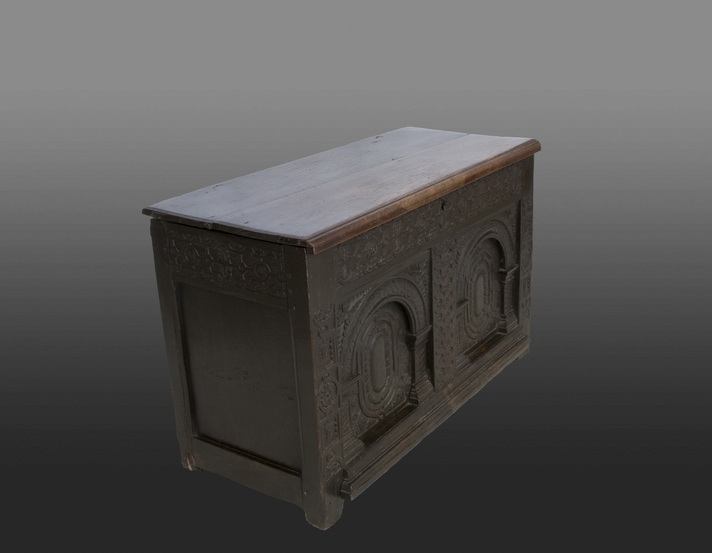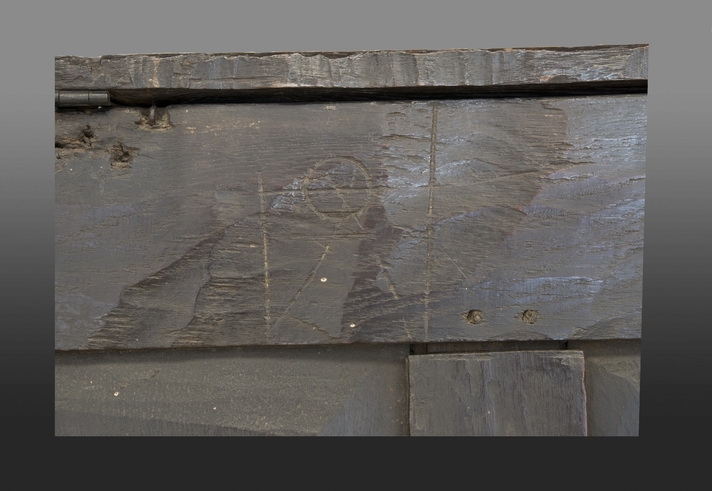Fixed woodwork in furniture form. While lift-top chests are an inherently common and conservative form, there is little about this chest which is humble or plain. It was likely constructed to stand in an elaborately ornamented room such as the ‘Oak Room’ in the now destroyed Bympfylde house in the centre of Exeter. The chest employs the same motifs and patterns and replicates the design of the suite of Bympfylde paneling. The front and side top rails feature another, more complex variation of the formalized strapwork introduced to Exeter by immigrant Netherlandish joiners and masons. This pattern which is carved on the wall plates of the Bympfylde paneling consists of alternating plumes and flowerheads contained within a complex grid. Appearance of this pattern is the most direct link between Exeter-made joined movable furniture and the ornament prints of Jan Vredeman de Vries as it appears on architectural columns, plinths, and friezes throughout [Architectura] Das Erst Buch (Antwerp, 1560-1564). An elaborated version of the lozenge and rosette strapwork carved on the front top rail of cat. 2 runs down the front stiles of this chest. A similar version of this pattern is also carved in several places on the Bympfylde paneling. A chain motif based on a design from the 1537 pattern book Regole generali d'architettura [General Rules of Architecture] by Sabastiano Serlio is carved on the front muntin. The architectural feel of the chest is enhanced by the use of set-back panels. Rather than being inserted into grooves, panels of this type are applied directly to the rear surfaces of adjacent framing members thereby more deeply recessing the panel and exaggerating the shadow effect. This technique is most often employed on prominently positioned panels from fixed woodwork such as the overmantle from the Bympfylde Oak Room. The architectural sophistication of this chest is particularly evident in the constant variation of the carving. Each rosette contained within the five courses of formalized strapwork on the front and side rails varies from one to the next. The small knots conjoined within the chain motif on the front muntin alternate between segmented and spiraled forms. This subtle detail would have been quite costly as it required the carver to break from routine and consciously insert new elements within the pattern. The timber used in the chest, like cat. 2, is high-quality local oak employed in almost profligate amounts by comparison to later Exeter joined furniture, indicating a date before the near wood-famine that began in Exeter during the last decade of the sixteenth-century.
Several of the motifs that appear on this architectural chest survive in a down-scaled form in the work of Thomas Dennis as well as other seventeenth-century joiners in Exeter. A carved box with drawer which descended in the Dennis family (Bowdoin College Museum of Art) is carved with a version of the de Vries-derived strapwork on this chest. The gouge accented leafage on the front panels recur on Exeter-derived carving in both England and New England. Notable examples of this are the semi-circle leaves on the panels which also appear on the central panel of cat. 8.
Condition
Edges of lid trimmed; hinges replaced; one arcade and several minor pieces of applied ornament restored.




